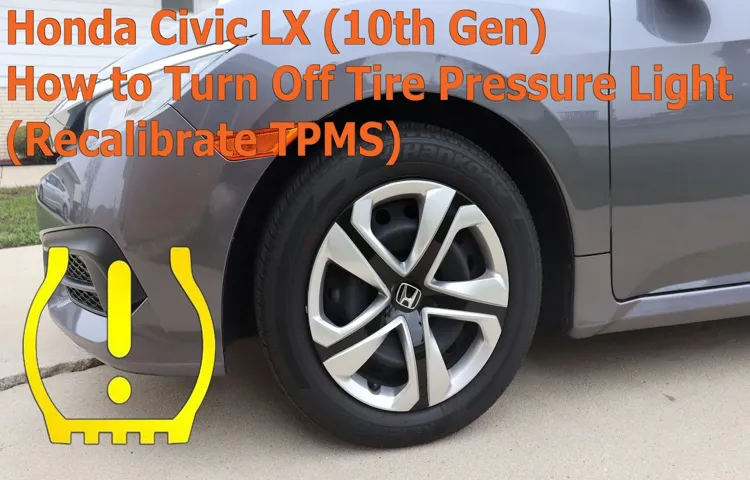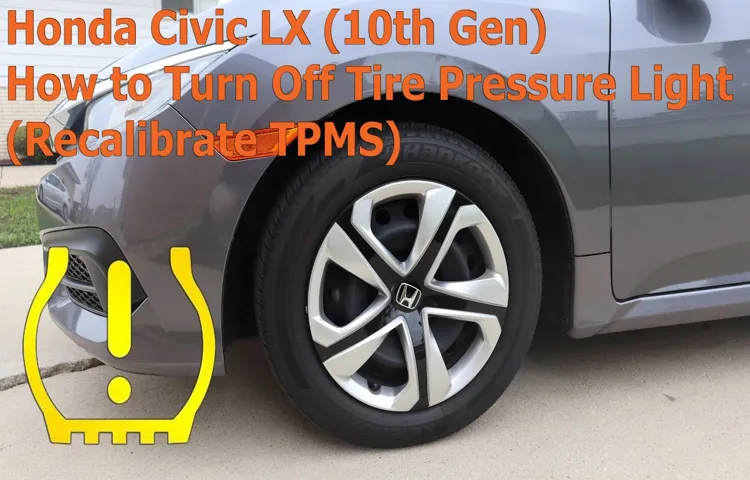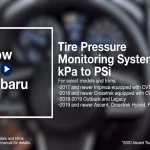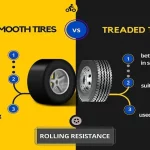If you’re a Honda Civic owner, you might have experienced the tire pressure light flashing on your dashboard. It’s a common issue that can cause confusion and frustration, especially if you don’t know how to turn it off. But don’t worry, we’ve got you covered.
In this blog, we’ll show you how to turn off the tire pressure light on your Honda Civic. Having the tire pressure light on doesn’t necessarily mean your car needs immediate attention, but it’s always best to check your tires as soon as possible. Your vehicle’s tire pressure monitoring system detects when one or more tires are underinflated, which could potentially lead to tire failure or poor fuel efficiency.
Thankfully, turning off the tire pressure light on your Honda Civic is a simple process. Depending on the model year, the steps may vary slightly. However, in general, it involves using the buttons on your car’s dashboard and resetting the system.
By following our easy-to-follow instructions, you’ll be able to turn off the tire pressure light in no time. Plus, you’ll have the peace of mind knowing your tires are properly inflated, which is vital for your safety and the longevity of your vehicle. So, let’s get started on turning off that pesky tire pressure light on your Honda Civic.
Table of Contents
Introduction
Are you tired of seeing the tire pressure light on your Honda Civic dashboard? Don’t worry; turning off this pesky warning light is a simple process. First, check the air pressure in all four tires to ensure that they have the correct amount of air. If the pressure is low, add air until it reaches the recommended level.
Next, locate the button labeled “TPMS reset” near the steering wheel and press and hold it until the tire pressure light blinks twice. Finally, release the button and wait a few seconds for the light to stay solid. Voila! Your tire pressure light should now be off, and you can get back on the road with peace of mind.
Remember, it’s crucial to check your tire pressure regularly to avoid potentially dangerous situations.
Explanation of tire pressure light
Tire pressure lights are pretty common on the dashboard of most modern vehicles. They’re designed to alert drivers about low tire pressure, which can be a serious safety hazard while driving. However, many drivers are confused about what this light means and why it keeps turning on.
Essentially, the tire pressure light is activated by a sensor located inside each tire that monitors the air pressure. When the pressure drops below the manufacturer’s recommended level, the sensor triggers the light. This typically means that there is a puncture, leak, or simply needs some additional air.
As a driver, it’s essential to check your tire pressure frequently and ensure that all tires are set to the recommended level to avoid safety hazards on the road.

Why it’s important to address the light
When it comes to creating the perfect ambiance for your space, lighting is often overlooked and understated. It’s easy to get caught up in choosing the furniture, decor, and color scheme, but lighting plays a crucial role in setting the mood and enhancing the overall atmosphere. In fact, it’s not just about the aesthetic appeal, but also about functionality and health benefits.
When we’re exposed to too much artificial light, it can disrupt our natural sleep patterns, cause eye strain, and contribute to headaches and migraines. On the other hand, the right balance of natural and artificial light can increase productivity, boost mood, and even improve cognitive function. As such, it’s important to address the light and find the optimal lighting solution for your needs.
Steps to Turn Off Tire Pressure Light on Honda Civic
If you’re seeing a tire pressure light on your Honda Civic’s dashboard, don’t worry, you’re not alone. It’s a common issue and can be quickly resolved by following a few easy steps. First, locate the tire pressure monitoring system button on your dashboard, typically located under the steering wheel.
Once you’ve found the button, press and hold it until the tire pressure light begins to blink. Then, let go of the button, and the light should turn off. If the light continues to stay on, you may need to check your tire pressure using a tire gauge and adjust the pressure to the manufacturer’s recommended level.
Keep in mind that in some cases, the tire pressure light may indicate a puncture or leak in one of your tires. If you suspect this is the case, it’s essential to get your vehicle inspected by a trusted mechanic as soon as possible to prevent further damage or accidents. Overall, turning off the tire pressure light on your Honda Civic is a quick and straightforward process that can save you an unnecessary trip to the mechanic.
If you’re a proud owner of a Honda Civic, you may have come across the tire pressure light turning on. Don’t worry; it’s a common issue that many car owners face. The first step in turning off the tire pressure light is to locate the tire pressure reset button.
In most Honda Civics, the reset button is located in the glove box. Simply open the glove box, and on the left-hand side, you’ll find a small button labeled “TPMS.” Press and hold this button until the tire pressure light on your dashboard blinks twice, indicating the system has been reset.
It’s important to note that if the tire pressure light continues to come on after you’ve reset it, you may have a more severe tire issue that needs attention. In that case, consult a professional mechanic to avoid further damage or potential accidents on the road. Remember, maintaining your tires’ proper inflation not only keeps you safe but also extends the life of your Honda Civic’s tires.
Step 2: Turn on car ignition
If you’re looking to turn off the tire pressure light in your Honda Civic, there are a few simple steps you can follow. The first one is to make sure that all four of your tires are properly inflated. Once you’ve done that, the next step is to turn on your car’s ignition.
This will allow your car’s computer to recognize that the tire pressure sensors are working properly and reset the system. If the light doesn’t turn off immediately, you may need to drive your car for a few minutes to allow the sensors to fully recognize the new tire pressure levels. Overall, this process is quick and easy, and it’s important to take care of your tires to ensure that your car is running smoothly and safely on the road.
If you’re driving a Honda Civic and your tire pressure light is on, it can be a bit concerning. But don’t panic! Turning off the tire pressure light on a Honda Civic is actually quite simple. The first step is to ensure that all of your tires are properly inflated to the correct pressure.
Once you’ve done that, locate the tire pressure reset button, which is usually located under the steering wheel. Press and hold this button for several seconds until the tire pressure light turns off. It’s really that easy! Just make sure you do this process every time you add or remove air to your tires, and you’ll be good to go.
Don’t forget to prioritize your safety and check your tire pressure regularly to avoid any unexpected blowouts on the road.
Step 4: Check dashboard for successful reset
If you’re trying to figure out how to turn off the tire pressure light on your Honda Civic, there are a few steps you can follow to get the job done. The first thing you’ll need to do is check the tire pressure in each of your tires and make sure they’re all properly inflated. If one or more of your tires is low, that could be the reason why the tire pressure light is on.
Once you’ve made sure your tires are all at the correct pressure, you can move on to step two, which is to drive for a few miles to give your car’s computer system a chance to register the changes in tire pressure. After that, step three involves pressing the tire pressure reset button, which is typically located under the steering wheel. Finally, to make sure the reset was successful, check your car’s dashboard to see if the tire pressure light has turned off.
If it has, you’re good to go! Just remember to keep an eye on your tire pressure regularly to prevent future issues.
Additional Considerations
If you’re wondering how to turn off the tire pressure light on your Honda Civic, it’s important to note that every generation of Civic may require a slightly different process. However, there are some general steps that can apply to most models. Firstly, ensure that your tire pressure is at the recommended level set by the manufacturer.
You can find this information in your Civic’s owner manual or on the driver’s side doorjamb. Once your tires are adequately inflated, turn on the ignition without starting the engine. You should see the tire pressure warning light flash on the dashboard.
Hold down the reset button, which is usually located near the steering wheel, until the light starts flashing consistently. Release the button and restart your engine. Your tire pressure light should now be off.
Keep in mind that if the light remains on, it could indicate an ongoing issue with your tire pressure and it’s recommended that you have it checked by a professional.
Checking tire pressure regularly
While checking tire pressure regularly is an important step in maintaining your vehicle, there are a few additional considerations to keep in mind. One of the most important things to remember is to check your tire pressure when they are cold. This means checking them before you drive your car or at least three hours after it has been driven.
The reason for this is that as tires heat up during driving, the air inside will expand, giving you an incorrect reading if you measure the pressure then. Another consideration is to make sure that you are using a reliable tire pressure gauge. Some gas stations may have gauges that are not accurate, so it is best to invest in your own gauge.
Additionally, when filling tires, it is important not to overinflate them. While you may think having more air in the tire will help with fuel efficiency, overinflated tires can actually cause a bumpy and less stable ride. By keeping these additional considerations in mind, you can ensure that you are checking your tire pressure effectively and safely.
Possible underlying issues with tire pressure
One additional consideration when dealing with tire pressure issues is the age of the tires. As tires age, they can become less flexible and more prone to leaks and punctures. This can result in a gradual loss of pressure over time, even if there are no obvious signs of damage.
Additionally, tires that are too old may not be able to hold air pressure properly, resulting in imbalanced wear and poor handling. To avoid these issues, it’s important to regularly inspect your tires and replace them when they become worn or damaged. This will not only ensure optimal tire pressure, but also improve overall safety on the road.
So, don’t forget to check the age of your tires and consider replacing them if they are past their prime.
Conclusion
In conclusion, turning off the tire pressure light on a Honda Civic requires a bit of know-how and some patience. It’s important to remember that this light is not just a nuisance, but a helpful reminder to ensure your tires are properly inflated to avoid potential safety hazards and costly repairs. So, if you’re looking to turn off the tire pressure light, make sure to check your tire pressure first and follow the appropriate steps outlined in your Honda Civic owner’s manual.
And if all else fails, don’t be afraid to ask for help from a trusted mechanic or Honda dealership. After all, safety first, wit and cleverness second!”
FAQs
What is the tire pressure monitoring system in Honda Civic?
The tire pressure monitoring system (TPMS) ensures that the tire pressure light in your Honda Civic alerts you when any of the tires are significantly underinflated.
Why does the tire pressure light come on in Honda Civic?
The tire pressure light in Honda Civic may come on if the tire pressure is too low, too high, or if there is a problem with the tire pressure monitoring system.
How do I check the tire pressure in Honda Civic?
You can check the tire pressure in Honda Civic by using a digital tire pressure gauge. Locate the tire pressure monitoring system button in your car and press it. The tire pressure readings for each tire will be shown on the dashboard.
How much air pressure should I put in my Honda Civic’s tires?
The recommended pressure for Honda Civic’s tires is 32 PSI (pounds per square inch).
How often should I check the tire pressure in my Honda Civic?
It is recommended to check the tire pressure in your Honda Civic at least once a month.
How do I turn off the tire pressure light in my Honda Civic?
To turn off the tire pressure light in Honda Civic, adjust the tire pressure so that it matches the recommended PSI. Then, drive for a few miles to allow the TPMS to reset itself.
What should I do if the tire pressure light in my Honda Civic keeps coming back on?
If the tire pressure light in Honda Civic keeps coming back on, there might be a problem with the tire pressure monitoring system. Get it inspected by a certified Honda technician.



